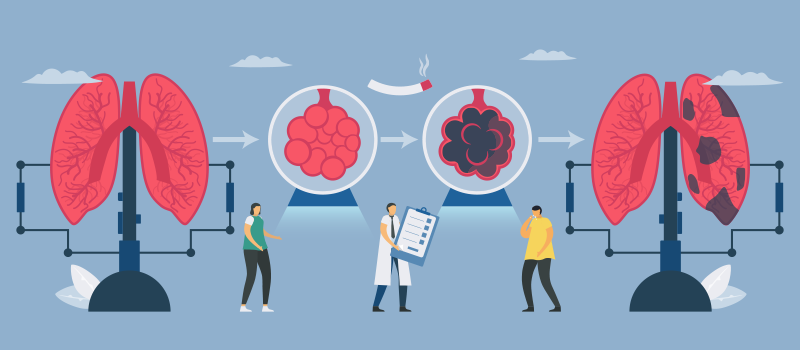What’s the Buzz
The Bee Healthy Blog
COPD vs. IPF (Idiopathic Pulmonary Fibrosis)

Chronic obstructive pulmonary disease (COPD) and idiopathic pulmonary fibrosis (IPF) are chronic, disabling lung diseases that cause many of the same symptoms. But IPF and COPD are not the same and cause different types of damage to the lungs. COPD is associated with pulmonary inflammation and IPF with lung scarring.
Please continue reading to learn more about the clinical features of chronic obstructive pulmonary disease and idiopathic pulmonary fibrosis. Find out in what ways these progressive diseases are similar and how they differ. Also learn why early treatment is essential for both COPD and IPF.
What is chronic obstructive pulmonary disease COPD?
Chronic obstructive pulmonary disease (COPD) is an inflammatory condition of the lungs that causes airflow obstruction, making it difficult to breathe. Other symptoms of COPD include wheezing, cough, and mucus. COPD is frequently caused by long-term exposure to cigarette smoke or environmental toxins. People with chronic obstructive lung disease are at increased risk of developing lung cancer, cardiovascular diseases, and other serious health conditions.
There are two lung conditions that commonly contribute to COPD - emphysema and chronic bronchitis. Emphysema involves the alveoli (air sacs) in the lungs, which are destroyed by prolonged exposure to cigarette smoke, particulate matter, or irritating gases. Chronic bronchitis is an inflammation of the lining of the air passages. Both emphysema and chronic bronchitis can be present in people with COPD.
Chronic obstructive pulmonary disease is a progressive disease that gets worse over time. However, it is treatable. Proper management can allow most people with this lung disease to achieve control over their symptoms and have a good quality of life.
What is idiopathic pulmonary fibrosis IPF?
Idiopathic pulmonary fibrosis is a condition that involves lung scarring, which makes breathing difficult. Other symptoms of IPF can include persistent cough, fatigue, loss of appetite, weight loss, and clubbed fingers (swollen and rounded tips).
Idiopathic pulmonary fibrosis sometimes goes undetected because people put down their shortness of breath to old age or being out of shape. However, as the condition progresses, even light activities such as getting dressed can cause shortness of breath.
The exact cause of IPF is unclear, but it mostly affects people over the age of 70. IPF is rare in people under 50 years old. There are no treatments to stop or reverse the lung scarring. However, proper management of idiopathic pulmonary fibrosis can reduce how fast the disease gets worse.
What’s the difference between IPF and COPD?
Idiopathic pulmonary fibrosis and chronic obstructive pulmonary diseases are similar in some ways, but they are not the same. The similarities between IPF and COPD are that they are both chronic progressive lung diseases that worsen over time. Both conditions can cause similar symptoms, such as breathing difficulties. The key differences between the two are described in the paragraphs below.
Type of Lung Damage
Idiopathic pulmonary fibrosis
IPF is classified as interstitial lung disease, affecting the lung tissue between other structures like blood vessels, air sacs, air passages, etc. In people with pulmonary fibrosis and other interstitial lung diseases, the cells between lung structures are damaged.
Chronic obstructive pulmonary disease
COPD is a more common type of lung damage. It can consist of emphysema, chronic bronchitis, or both. In people with COPD, the alveoli (air sacs) are damaged or destroyed. Also, there is pulmonary inflammation (the airways may be irritated and swollen).
Prevalence
IPF is a rare disease affecting an estimated 100,000 people in the United States. Around 30,000 to 40,000 new cases are diagnosed each year. Unfortunately, the condition is often not diagnosed until permanent scar tissue has formed in the lungs.
COPD is much more common. It affects approximately 16 million Americans, which could be an underestimation. The American Lung Association believes up to 24 million adults in the U.S. could be living with impaired lung function due to COPD. Many people with COPD have a mild form of the disease and are not diagnosed until the condition has progressed. The CDC lists COPD as a leading cause of death in the United States.
Causes
It is unknown why some people develop pulmonary fibrosis. The disease can have an unpredictable course.
In contrast, the cause of COPD is well known. Cigarette smoking is implicated in about 90% of cases. In addition, the course of COPD has been well studied.
Risk Factors
Risk factors for idiopathic pulmonary fibrosis include age over 60 years; gender (men are diagnosed more often with IPF than women); family history of IPF; occupational exposure to dust, fumes, or chemicals; smoking; radiation therapy to the chest, for example, to treat lung cancer; and certain chemotherapy medications, antibiotics, and heart medications.
Risk factors for chronic obstructive lung disease include smoking, including exposure to secondhand smoke; age over 40; occupational exposure to dust, fumes, and chemicals, gender (women who don’t smoke are more likely to develop COPD than men who don’t smoke); and a family history of COPD.
As you can see, many risk factors are common for these two lung diseases.
Can COPD be mistaken for IPF?
Idiopathic pulmonary fibrosis is underdiagnosed. It is also frequently misdiagnosed because it shares many features with other lung diseases, including chronic obstructive pulmonary disease (COPD) and asthma. Many of the signs and symptoms of COPD and IPF are similar, including progressively worsening shortness of breath, chronic cough, tiredness, clubbed fingers, and weight loss. Both conditions are made worse by respiratory infections.
One difference between the two is the type of cough they cause. The cough in COPD is produced by sputum (mucus), while IPF produces a dry cough. People with COPD can develop additional symptoms such as cyanosis (blue fingertips and lips) due to low oxygen levels, chest tightness, and swollen ankles and feet.
Can you get combined pulmonary fibrosis and COPD?
In people with combined pulmonary fibrosis and emphysema syndrome, either COPD or IPF typically predominates. As a result, it is rare for an individual patient to be diagnosed with both diseases simultaneously. However, smokers can display changes in lung tissue consistent with both interstitial lung disease (IPF) and pulmonary emphysema (COPD).
Pulmonary function tests (measures of lung volumes) in such individuals are different from pure fibrosis or pure emphysema. However, traditional diagnostic tests are limited in identifying the simultaneous occurrence of both idiopathic pulmonary fibrosis and chronic obstructive pulmonary disease.
High-resolution computed tomography (CT) scan may provide enhanced recognition of the simultaneous occurrence of these lung diseases. The presence of concurrent chronic obstructive lung disease and idiopathic pulmonary fibrosis may also be discovered on radiographic examination, which might show interstitial lung abnormalities as well as upper lobe emphysema, for example. This can be correlated with clinical features such as significant smoking history, severe pulmonary hypertension, and shortness of breath.
Is idiopathic pulmonary fibrosis a death sentence?
There is currently no cure for IPF. Instead, it gets progressively worse over time and eventually leads to death. For this reason, healthcare providers consider idiopathic pulmonary fibrosis a terminal illness.
However, proper management and treatment can relieve symptoms and slow down the progression of the disease. Doctors can treat pulmonary fibrosis with medications, oxygen therapy, and pulmonary rehabilitation. This is similar to COPD treatment in many aspects.
In select patients with pulmonary fibrosis, a lung transplant may be an option to improve life expectancy and quality of life. However, mortality among IPF patients is high since waiting lists for lung transplantation are long, and most patients are referred with advanced disease.
References:
- https://www.mayoclinic.org/diseases-conditions/copd/symptoms-causes/syc-20353679
- https://www.nhs.uk/conditions/idiopathic-pulmonary-fibrosis/
- https://my.clevelandclinic.org/health/diseases/10959-pulmonary-fibrosis
- https://www.ncbi.nlm.nih.gov/pmc/articles/PMC3282644/
- https://jtd.amegroups.com/article/view/4243/4710
- https://www.ncbi.nlm.nih.gov/pmc/articles/PMC3251269/
- https://medlineplus.gov/genetics/condition/idiopathic-pulmonary-fibrosis/#statistics











SOCIAL